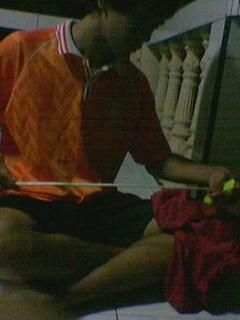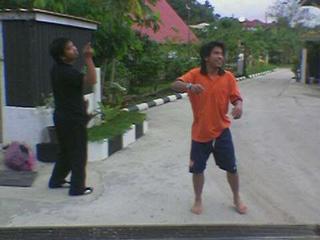The Dummy's Introductory Guide into the World of Kite-Flying
(illustrated by Maurina H)
Disclaimer: No one was physically harmed in any possible way during the making of this quasi-photo-documentary. All actors are acting voluntarilly under no coercion nor rasuah. (Fortunately for me)

1. This sport is usually more popular among teenage boys aged 12-21 years old, particularly if they are frustrated with boredom and burdened with stresses of unemployment.

2. The 'sport' is more often than not facilitated by hand made 'kikiks' (pronounced key-kicks) which are crafted and aerodynamically tested with purely traditional means - by instinct.
Basic things needed are; Temiyang (a sort of lightweight bamboo) for the main chassis (more commonly called alok-alok) of the flying instrument, glue (usually ambuyat is used), some lightweight oil paper usually of unusually bright colours and a roll of strong tangsi.
NB: seasoned kikik makers might dispute me on the things part. Please do not hesitate to add if I've left out some important bits.

3. Knowing the strength and direction of the wind is a great advantage.

4. With almost no effort, a skilled player can get a kikik up flying in the clouds within 5 minutes.
5. Within the next 10 minutes the player will keep the kikik floating in the sky, being careful not to let it get swept by the wind, and constantly making sure that their tangsi is not corrupting any unsuspecting phone lines in the process.

6. During the kikik season, kikik enthusiasts will constantly be on the look out for idle kikiks in the sky.An idle kikik is call for a challenge.

7. Thus, begin the pulut battle. These two opponents acknowledge each other's presence. A mutual understanding is reached through unspoken discourse.
The challenge is accepted.

8. These two kikiks will try to cut off each other's lines or tangsi.
The action is done with utter skill, sufficient knowledge of physics, aerodynamics and strong basic instinct.

9. If a match is particularly exciting (e.g. between two people notorious for their pulut skills) people would convene.
The match now has an audience. Additional pressure is added to the opponents. Wagers are thrown and shouts and yells of support are heard.

10. Eventually one kikik will break and the one still remaining up there would be hailed as the winner.
The floating kikik would be lost forever, free for anyone to salvage and admire.
...and all that is left, is a neck strain and a broken tangsi line.
The End
The End

No comments:
Post a Comment